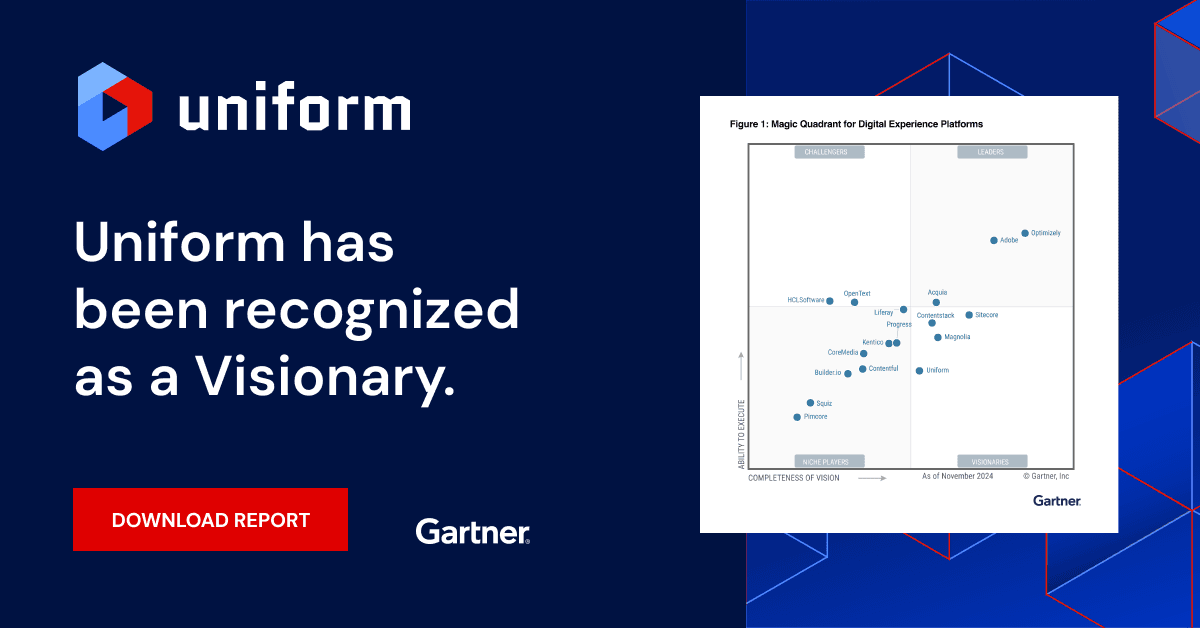Uniform blog/Uniform as a crucial tool for composable commerce
Uniform as a crucial tool for composable commerce
Uniform as a crucial tool for composable commerce
A 2020 report found that over three quarters of companies surveyed had adopted a headless approach for e-commerce or planned to do so within a year. And for good reason:
- Composable commerce enables developers to build digital experiences without the constraints imposed by traditional systems.
- Like headless CMS, composable commerce stores data irrespective of eventual delivery. As a result, you can sell on any page or channel you choose, becoming much more responsive as customers adopt new channels. As this article puts it, “The world is your storefront.”
Challenges of composable commerce
Unfortunately, certain benefits of composable commerce, particularly the freedom to build storefronts any way you desire, are problematic, posing challenges that don’t exist in traditional commerce platforms. A key issue is the inability of composable commerce to transform e-commerce from a simple catalog and ordering system into a full-fledged shopping experience.
Two reasons:
- By default, composable commerce shifts control away from marketers and merchandisers to developers, who must integrate and orchestrate systems, including commerce, content sources, customer-data sources, and marketing technology. As tools proliferate, it becomes increasingly difficult for business teams to take charge of the shopping experience without support from developers, hence delays in reacting to changing business conditions. Also, since developers are in short supply, implementation is more time consuming and costly.
- Composable commerce makes personalizing and previewing content tough to do—a rude awakening for business teams and a disappointment for customers.
In fact, according to a 2019 survey, 74 percent of customers feel frustrated with unpersonalized websites. However, adopting composable products is complicated, requiring that those products be connected so that they can work together. Uniform serves as the bridge for that connection in a composable architecture—a process called digital experience composition platform (DXCP) and a critical component for building digital experiences.
Uniform as the answer
For brands that desire the flexibility and speed of composable commerce along with the control accorded by legacy monoliths, the answer is Uniform. Available from Uniform for marketers are independent personalization tools that are absent in composable architectures in addition to the scalability, security, and speed that makes composable the choice for most modern e-commerce implementations. It’s the best of both worlds.
For marketers and merchandisers
Using Uniform Canvas’s no-code interface, marketers and merchandisers can easily build seamless e-commerce experiences. Here’s why:
- Developers lay the groundwork. Uniform connects headless content and commerce to the front-end frameworks, libraries, and tools that make up the “head” in headless commerce. That way, developers can set up the components and connections that business teams need, and then simply step back to let those teams publish independently.
- Business teams combine commerce, content, and the front end. With Uniform Canvas, a no-code tool, business teams can build experiences and instantly preview them by assembling the front-end components with any connected source and determining how to present them to the audience. This flexibility of input and output in a single step is extremely difficult to achieve with headless services without Uniform.
- Personalization that’s usable. A 2019 survey revealed that “80 percent of shoppers are more likely to buy from a company that offers personalized experiences.” Traditionally, to add personalization, you had to adopt a monolithic platform that was tightly coupled with the vendor’s commerce application. Plus, your audience had to wait while their information was sent to a server and the personalized content loaded on the page. All that caused sluggish performance and lower SEO rankings.
Not any more. You can now personalize your site with composable commerce and Uniform’s no-code interface for building experiences. They’re then delivered at the edge by the CDN of your choice without impacting page performance, so no more SEO impact or bounces from slow loading. Here, instead of incorporating the best of both worlds, Uniform offers a whole new world for personalization performance.
Unlike traditional origin-based, rules-oriented personalization, which can be complex to build and difficult to maintain, Uniform’s simple and intuitive personalization solution rests on two simple concepts:
- Intents, i.e., the goals of your site’s visitors
- Signals, i.e., the visitors’ real-time behaviors that make those intents clearer.
The purpose of personalization is to make it as easy as possible for visitors to realize their intents. Uniform’s innovative personalization interface blends seamlessly with your commerce tool so that you can tag components and content with intents and define the signals that support them. Afterwards, based on those intents and visitors’ real-time behaviors, Uniform’s personalization capability identifies your site’s most relevant content for your visitors anywhere you choose—not just on the product-details page. In addition, you can add A/B testing to components and preview personalization in real time.
Not surprisingly, such ease of use for marketers and merchandisers and enhanced visitor experience promise to raise profits for your brand. In fact, according to a forecast, “Smart personalization engines used to recognize customer intent will enable digital businesses to increase their profits by up to 15 percent.”
For developers
Uniform liberates developers from constraints imposed by proprietary commerce tools, giving them the freedom to build. In particular, developers can—
- Choose their tools and frameworks. Composable commerce with Uniform means you no longer have to work the way you do with legacy commerce tools. Uniform Mesh integrates your commerce tools and any other composable services as the front-end framework of your choice. You choose the best tools for the job.
- Build and adapt faster. Integrating through Uniform removes the need to spend weeks or months writing custom integration code. Instead, you add services to Uniform, input your API keys, and get to work. As business goals evolve or if customers adopt new channels, Uniform’s modular approach makes it straightforward to change or expand your stack without refactoring or replatforming.
- Work on features, not publication. Sometimes, the best gift is a little space. By giving your business colleagues the tools to create, test, and publish independently, you enable them to work at their own pace. Simultaneously, you have no publication tickets to handle and can focus on building value-add features.
The future of commerce is composable
By delivering the speed and agility that monolithic architectures cannot match and that are required in today’s fast-changing business climate, composable commerce is here to stay. However, a powerful commerce engine isn't enough: Since a modern commerce experience combines multiple services and channels, you need a digital-experience composition tool to coordinate them all.
With Uniform, you can quickly realize the full potential of composable commerce and create market-leading experiences, including personalization, which invariably drives conversions. Additionally, your developers can build the front end their way on a modern, performant architecture that readily adapts to your needs in an unpredictable market.
Contact us and learn how Uniform can accelerate your composable commerce experience.
More about composable architecture:
- Composable architecture: the what, why, and how
- When legacy met composable: a DXP love story
- The MACH monolith
- The move from monolithic to composable architectures
- Uniform as a crucial tool for composable commerce
- Switching vendors for digital architectures without replatforming
- A cheat sheet for getting composable right
- MACH versus monolithic suites





.png&w=1080&q=90)
.png&w=1080&q=90)
.png&w=1080&q=90)